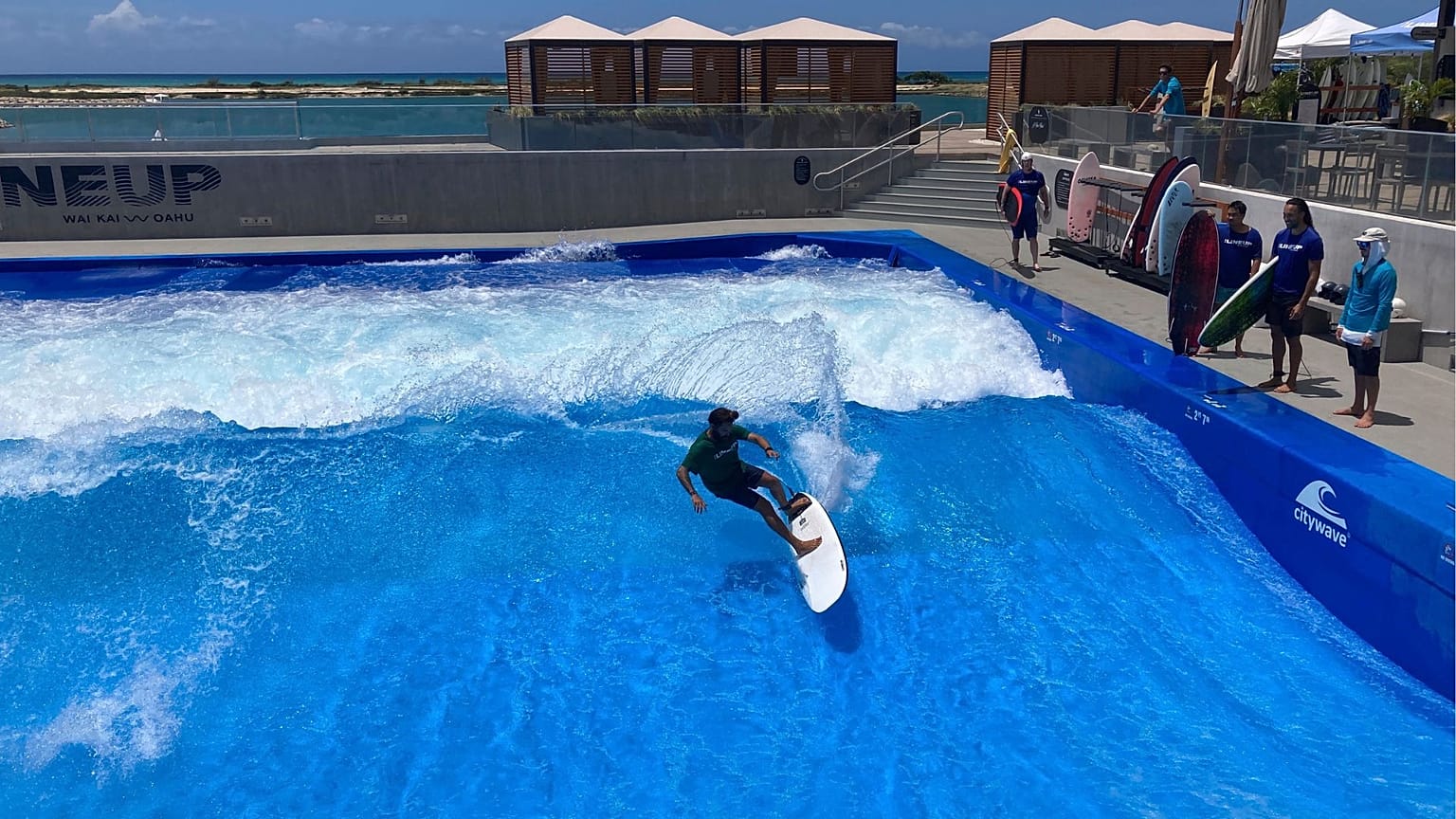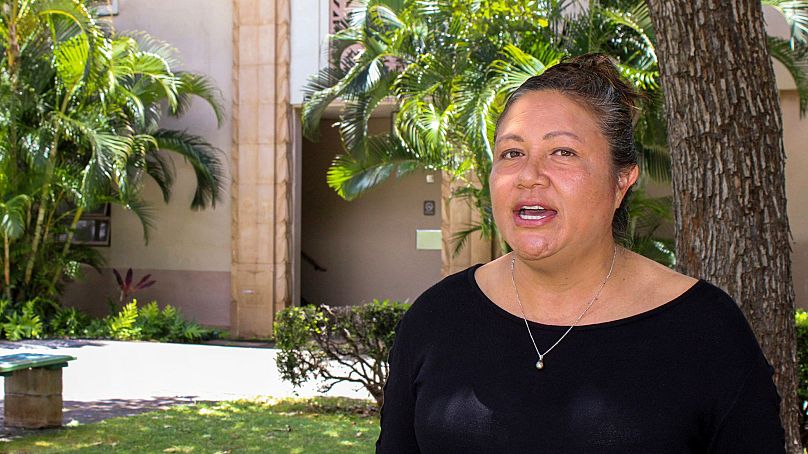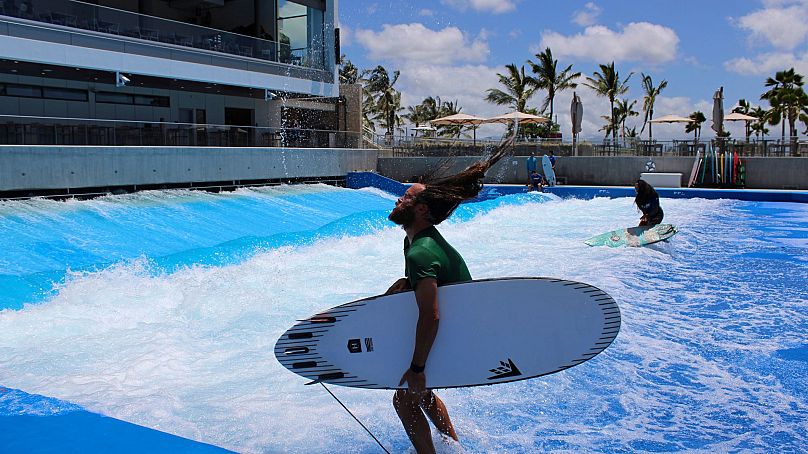Locals say the pool could damage a nearby beach but others say it's necessary for local surfers.
Brian Keaulana is the quintessential Native Hawaiian waterman, well-known in Hawaii and beyond for his deep understanding of the ocean, gifted with surfing and lifeguarding skills passed down from his big-wave rider father.
Now, as one of the islands' flag-bearers of surfing, Keaulana wants to help local surfers to keep honing their craft - even when there's no waves.
His plan is to build an artificial wave pool just down the road from the beach.
But it's made waves with locals who worry about the environmental impact the pool will have.
The endless search for the perfect wave
“The ocean is the greatest treasure that we have," Keaulana says, but "it can be flat. It can be big. It can be dirty. It can have, you know, sharks here and there."
He worries Hawaii's Olympic surfing hopefuls are at a disadvantage to competitors who can easily train at one of the surf parks worldwide. A wave pool allows for more time on a surfboard in an hour than most surfers get in the ocean in a week, he says.
“You see these surfers going to these surf parks and catching wave after wave and they are honing their skills and then they go into the ocean when there's a swell,” he said. “Boom. They're already primed and ready.”
What is the potential environmental impact of the wave pool?
The lawsuit against the wave pool has been filed in the state environmental court by a group of Hawaiians and residents who live near the proposed site.
They allege that the 7 million-gallon (26-million litre) artificial pool would damage nearshore 'limu', or seaweed, and desecrate 'iwi kupuna', or ancient Hawaiian remains.
Bidding to halt the project, the lawsuit challenges the Hawaii Community Development Authority’s approval and finding that it will have no significant environmental impacts.
The development authority and the state attorney general’s office declined to comment on the lawsuit, which seeks a new environmental review.
A hearing is set for July but it’s not clear when a judge might rule.
Why not go to the 'actual beach'?
“They’re profiting off a cultural practice by controlling it by making these wave pools, which are going to destroy the actual beach that is nearby,” says Healani Sonoda-Pale, a plaintiff in the case. “I cannot speak for other Hawaiians. All I can I say is as a Hawaiian... it goes against my culture.”
Sonoda-Pale, who calls herself a water protector, questioned whether a wave pool is really necessary to excel at surfing. While she surfed in her youth, she’s no longer an active surfer.
“I know as a cultural practice that from our histories, when the surf was up, families would drop everything they’re doing and go out and surf,” she says. “So, the timeline of when to surf, when it is a good time to surf... was made by nature, was made by Kanaloa,” she adds, referring to the Hawaiian ocean god.
Sonoda-Pale also points out that the artificial lagoon would be 2 miles (3.2 kilometres) from a beach called White Plains, long a popular surf spot.
A wave pool recently opened nearby and opponents say another one is unnecessary and a waste of water.
How would the wave pool create waves?
Using the latest technology, the facility would simulate ideal conditions needed to keep top surfers competitive and serve as a “life-saving lab” for teaching safety skills in a controlled setting, Keaulana says.
Keaulana's business partner Keno Knieriem explained that waves can be customised via an electromechanical system that would use panels to generate up to 1,000 waves per hour, mimicking ocean swells up to 8 feet (2.4 metres) high.
Some 80 surfers could work different waves simultaneously: barrelling waves, big waves, kid-friendly waves, Knieriem says.
“That would be sick,” says professional surfer Sheldon Paishon. He grew up surfing at Makaha, one of Hawaii's best surf spots, and now surfs all over the world, and has trained at other wave pools. “When the waves are small ... we could go there and do our thing.”
Will the wave pool try to save water?
Knieriem says the project would incorporate water conservation and off-the-grid electricity and feature native plants in its landscaping.
Besides a surf lagoon, the 19-acre (7.6-hectare) site also would feature rock climbing, beach volleyball, skateboarding and other activities. The proposed facility is eyeing a summer 2024 opening, though it's not clear how the lawsuit could affect the timeline.
“We’ve met with a number of Hawaiian cultural advisors and conducted extensive archaeological and environmental studies to ensure that we protect and mālama the site,” says a company statement, using the Hawaiian word that can mean “to take care of.”
Keaulana says he’s hopeful differences can be worked out with 'hooponopono', a traditional, culture-based form of mediation. Project opponents say they are open to such a meeting.
“I'm more disappointed in myself. I felt - and we felt - that we've pretty much tried to do everything possible,” Keaulana says of concerns about the project. “I just feel to be Hawaiian is to meet up and work your differences and problems out."




















